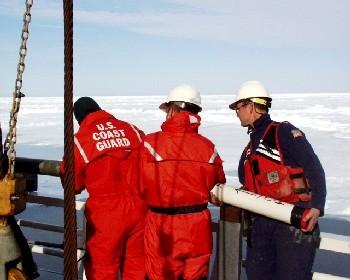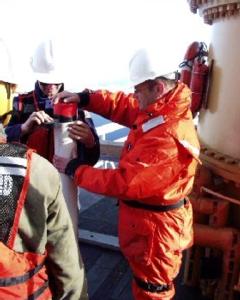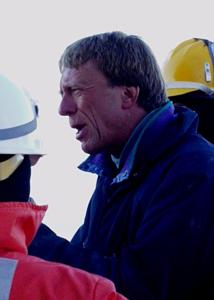21 June, 2000
21 June 2000
The Coring Crew And What They Do
During the past two days we have been doing coring - collecting a
cylindrical sample from the sediments deposited on the ocean floor. The
coring crew that came on board at our last stop in Nuuk includes Jim Broda
of Wood’s Hole Oceanographic Institute, and Pete Kalk and Chris Moser of
Oregon State University. Today’s journal focuses on these individuals and
their backgrounds as well as what they have been doing on board.
Jim Broda’s story will actually have to wait a few days. He’s so tied up
with the coring he only really has time to core, eat and sleep. He designed
the coring system that is on USCGC Healy and is here to make sure it is
working properly. Whether he is supervising the coring operations directly,
or observing the MSTs and other Healy crew conduct coring operations, Jim is
on top of everything that is going on during this test phase.
Pete Kalk is a Senior Research Assistant in the College of Oceanic and
Atmospheric Sciences (COAS) at OSU in Corvallis, Oregon. Pete started out
in forestry with a degree from Michigan Tech University and after a two-year
stint in the U.S. Army; he headed to graduate school in forestry at OSU.
When money ran out for classes, he took a job in oceanography at the school,
and has worked there ever since. He soon went from biological oceanography
with Dr. Bill Pearcy to marine geology where he has worked since 1971. His
job as a coring technician has taken him on 23 different research vessels,
and taken him to 26 countries including Costa Rica, where he was working
last month. Pete had to go through a major climate change as he made his
first trip to the arctic. He has Antarctic experience though, so knows what
to expect in these icy conditions.
Chris Moser is also a Senior Research Assistant at Oregon State. After
earning a Masters from OSU, Chris took a job as a research technician with
COAS. Chris has worked with coring, dredging, and moorings. While working
on JGOFS (Joint Global Ocean Flux Study), he was working with moorings
similar to what we were testing on the previous leg of this cruise. He does
not teach in the classroom at OSU, but he has taught scientific sampling
techniques and data analysis to many graduate students on an individual
basis. On this leg, he is helping teach the HEALY’s crew how to properly
use this coring system. Both he and Pete have been highly complimentary
about the ship’s personnel regarding their helpfulness and willingness to
learn as they work.
The work these three men do provide cores of sediment that are analyzed in
a variety of ways by researchers around the world. The data generated by
this research can provide some interesting information about our planet’s
past. That topic will be discussed in tomorrow’s journal. For a very
complete, step-by-step description of the actual coring process; from
assembly, to recovery, to extrusion of the sediment core itself, see Todd’s
journals for June 21st and 22nd.
Note: Happy Solstice - If you are in the Northern Hemisphere, it’s the
longest day of the year - doesn’t mean much up here though, the sun hasn’t
set here for over a month, and still won’t set for yet another month!

4. Todd and El remove the first section of core. (Photo by Lisa)

Pete Kalk checks the coring assembly put together by the Healy's crew.

I use the strap wrench to hold the liner in place while Chris cuts a 5' section. (Photo by Lisa)

2. Chris Moser removes the core catcher from the bottom of the core. (Photo by Todd)

5. Todd tapes the end cap on - Take this one to storage. (Photo by Dr. L. Lawver)

Jim Broda instructs the Healy's crew in coring operations.

1. Jim Broda and El McFadden hook up the extruder to push the core and liner out of the barrel .(Photo by Todd)

Chris Moser watches carefully over the Healy crew as they work on the second core.
Contact the TEA in the field at
.
If you cannot connect through your browser, copy the
TEA's e-mail address in the "To:" line of
your favorite e-mail package.
|
